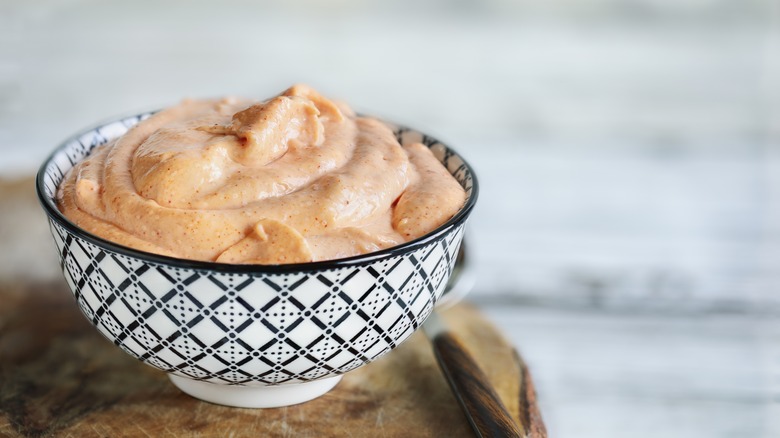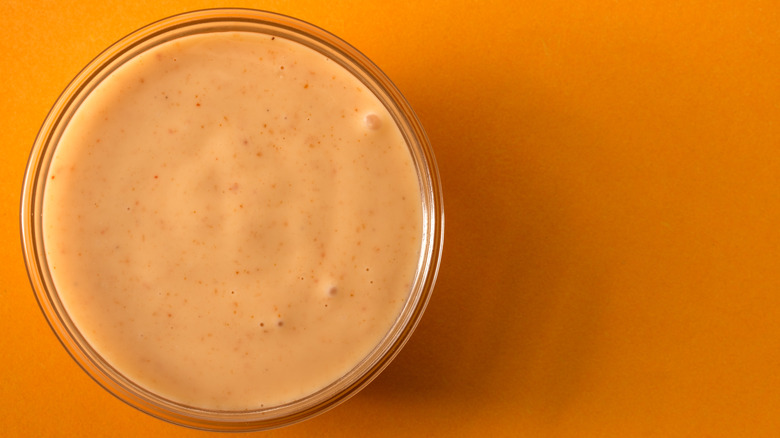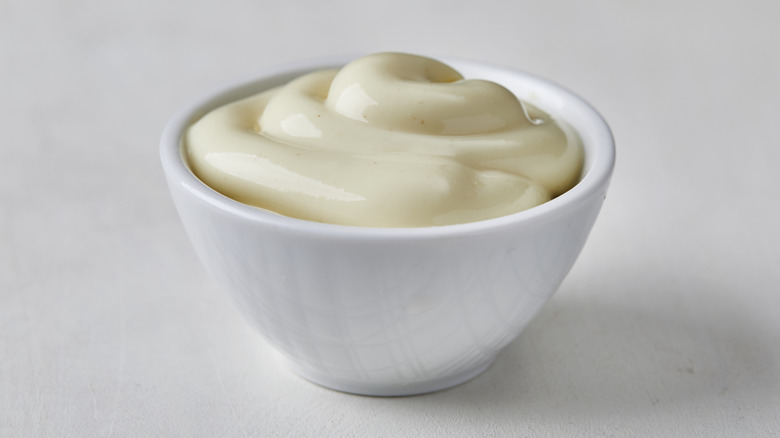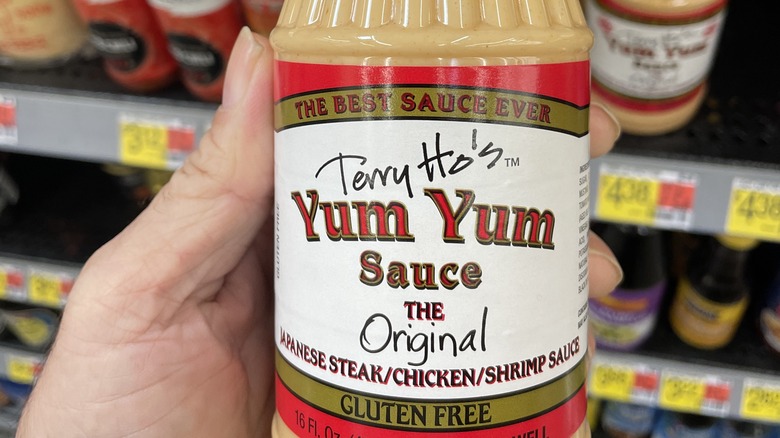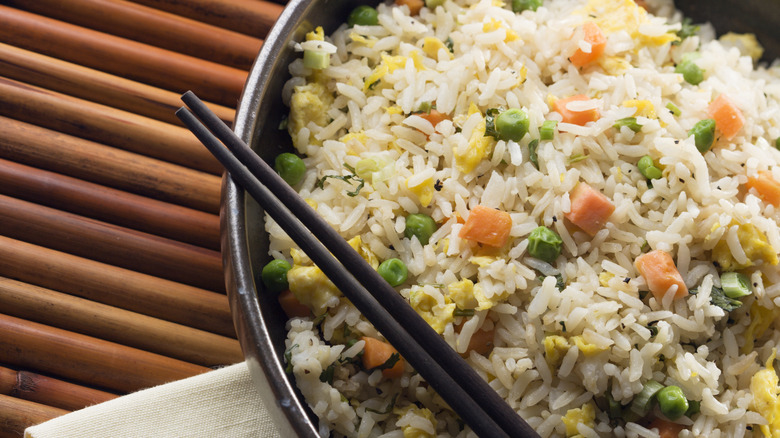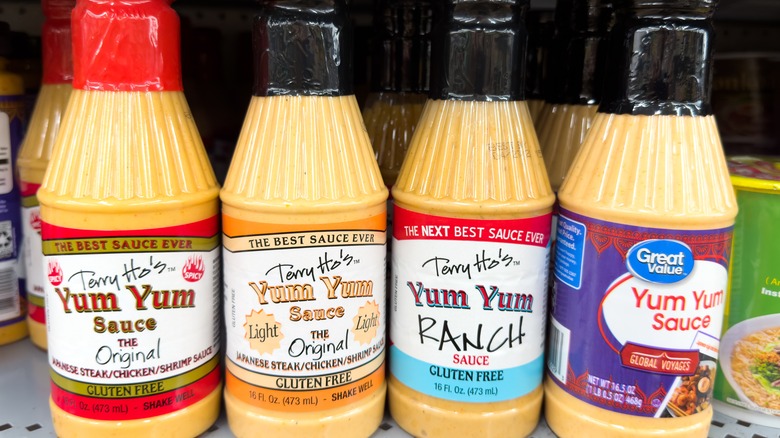What Is Yum Yum Sauce Exactly?
When people think of condiments, they typically think of things like ketchup, mustard, mayonnaise — stuff most Americans have in their fridge. But the world of condiments is so much more vast than that, and the options are nearly limitless for things to put on sandwiches or dip your fries into. There's spicy stuff like buffalo sauce or horseradish-based sauces, sweeter condiments like relishes and chutneys, and the culinary overlap with salad dressings means there's no reason something like blue cheese or Thousand Island can't also be used as a condiment.
But the region of the world that truly shines and deserves a lot more attention when it comes to condiments is Asia. The Asian continent has produced a lot of great condiments that serve different purposes, from peanut sauce and soy sauce to Chinese mustard, but there's one from Japan you've probably had but might not know the name for: Yum Yum sauce. You should be using it a lot more because it's simply delicious.
Where have you seen Yum Yum sauce?
Have you ever eaten at a Japanese steakhouse and been given those two little dishes of dipping sauce, one brown, one pinkish-white? Yum Yum sauce is the pinkish-white one, made primarily of mayonnaise, tomato paste, and spices like paprika (and maybe a dash of very mild hot sauce). And while there may occasionally be Yum Yum sauce-related disasters in a restaurant setting (like the time a restaurant employee added plumber's lye to the mix), not only is it perfectly safe, it's mild enough to be pleasing even for the pickiest American palates.
It's also sometimes referred to incorrectly as "Japanese mayo," which is a misnomer. Japanese mayo is a thing, and if you've never had the singular pleasure of kewpie, you really should try it. But that's different from Yum Yum sauce — although since both are lightly colored, egg-based Japanese condiments, it makes the mistake somewhat understandable.
How is Yum Yum sauce made?
There's nothing particularly complicated about how Yum Yum sauce is made; it's a condiment that consists of a mix of other ingredients, so its creation process is pretty simple. And while there are all sorts of recipes for Yum Yum sauce that produce slightly different flavor profiles and textures, there are also some commonalities between them. Pretty much all recipes will start with mayonnaise and will also involve paprika (either sweet or hot, depending on preference), rice vinegar, and water just to thin out the mixture.
From there, there's usually a tomato element. Some homemade recipes use ketchup, but that typically isn't part of the major brands. Instead, those make use of tomato paste, which lends a more concentrated tomato flavor without ketchup's sometimes overpowering sweetness. The other ingredients vary — you'll see recipes with butter, salt, pepper, garlic powder, and maybe even a little sugar — but those are the core components.
What does Yum Yum sauce taste like?
Because Yum Yum sauce is mayonnaise-based, it does share some flavor profiles with mayonnaise as a light, vaguely eggy dipping sauce. The combination of ketchup and mayonnaise means it does share some mild similarities to fry sauce (a mixture of ketchup and mayo popular as a DIY condiment). Still, because you're using tomato paste rather than ketchup, it lacks the taste ketchup brings to the table. The best way to describe its flavor is light; it has a delicate taste that complements proteins rather than overpowering them.
The texture, meanwhile, is more viscous than something like soy sauce but not nearly as thick as mayonnaise (or even ketchup or mustard) owing to the addition of water. Its light, airy texture — in addition to similar qualities in its flavor profile — is another reason it works so well as a dipping sauce. Both its flavor and texture make it highly versatile.
How to cook with Yum Yum sauce
Typically, you're not going to want to cook with Yum Yum sauce; it's not intended as a cooking component, but as a dipping sauce. It's worth noting that while it's intended for steak, the creamy texture and light flavor of Yum Yum sauce will go with pretty much anything that can be dipped if you feel like it. French fries? Perfect. Vegetables, either cooked or raw? Absolutely. Shrimp? Hey, no one's stopping you. There's really no limit here other than your own imagination.
That being said, there are ways you could theoretically cook with it. The best would probably be to use it as a mix-in for a dish that's already cooked, like fried rice; this isn't technically how it was intended as a dipping sauce, but the result would be to create something sort of like an Asian risotto, which does sound pretty delicious.
Where to buy Yum Yum sauce
The good news is Yum Yum sauce isn't hard to find at all. There was a time when you could only acquire it in specialty stores, but those days are over; the rise of Japanese steakhouses like Benihana in America means that even if customers aren't familiar with the eye-catching name, they're likely to have eaten it before (and let's be honest, the aesthetically pleasing color doesn't hurt it, either). As such, you can now find Yum Yum sauce in most major grocery stores. Terry Ho's is probably the most popular brand, but many grocery stores will sell multiple brands, so feel free to experiment until you determine your favorite kind.
All in all, Yum Yum sauce is a great condiment to keep in your fridge next to staples like ketchup, mayo, and mustard. Expand your culinary horizons and try it sometime; you'll be glad you did.
